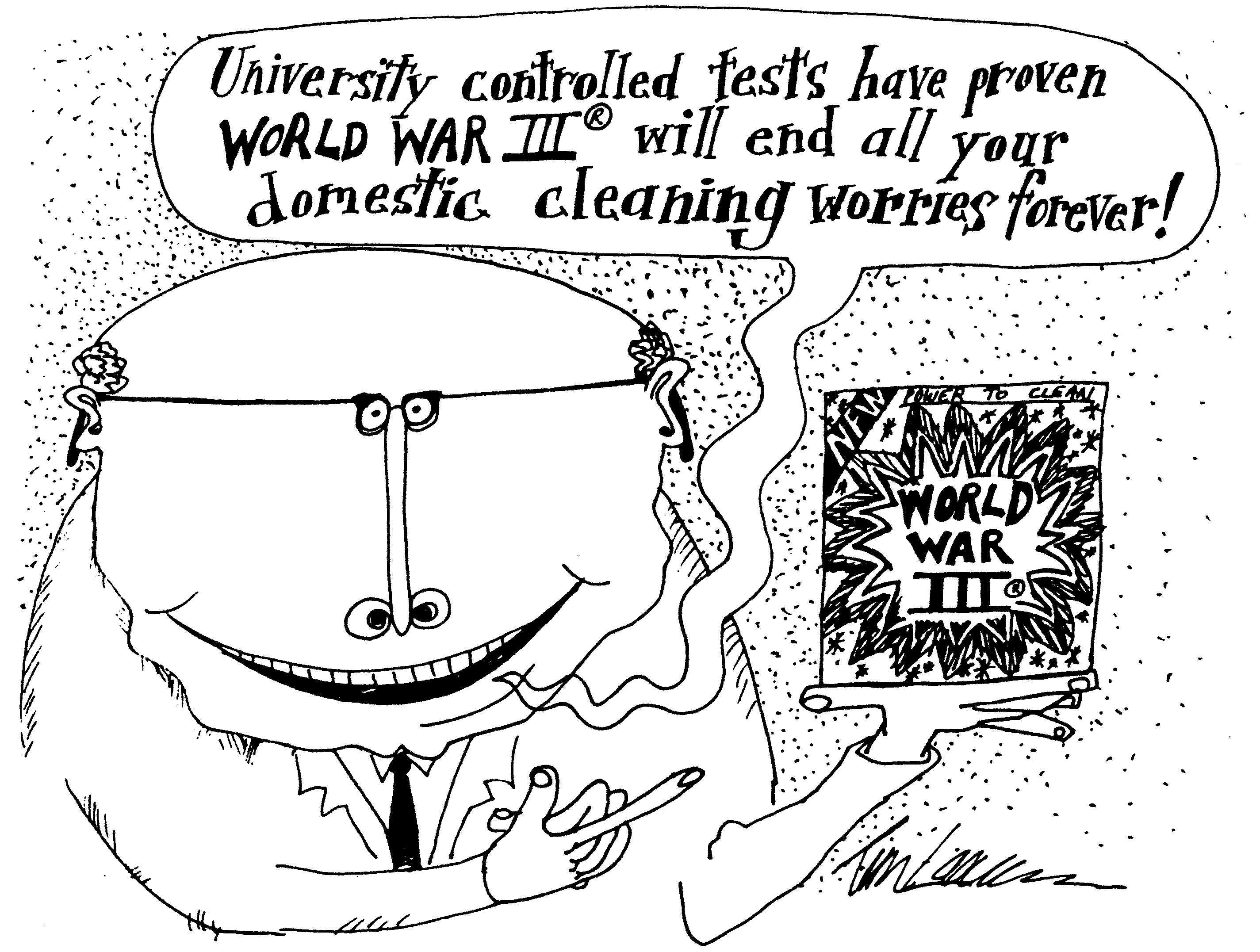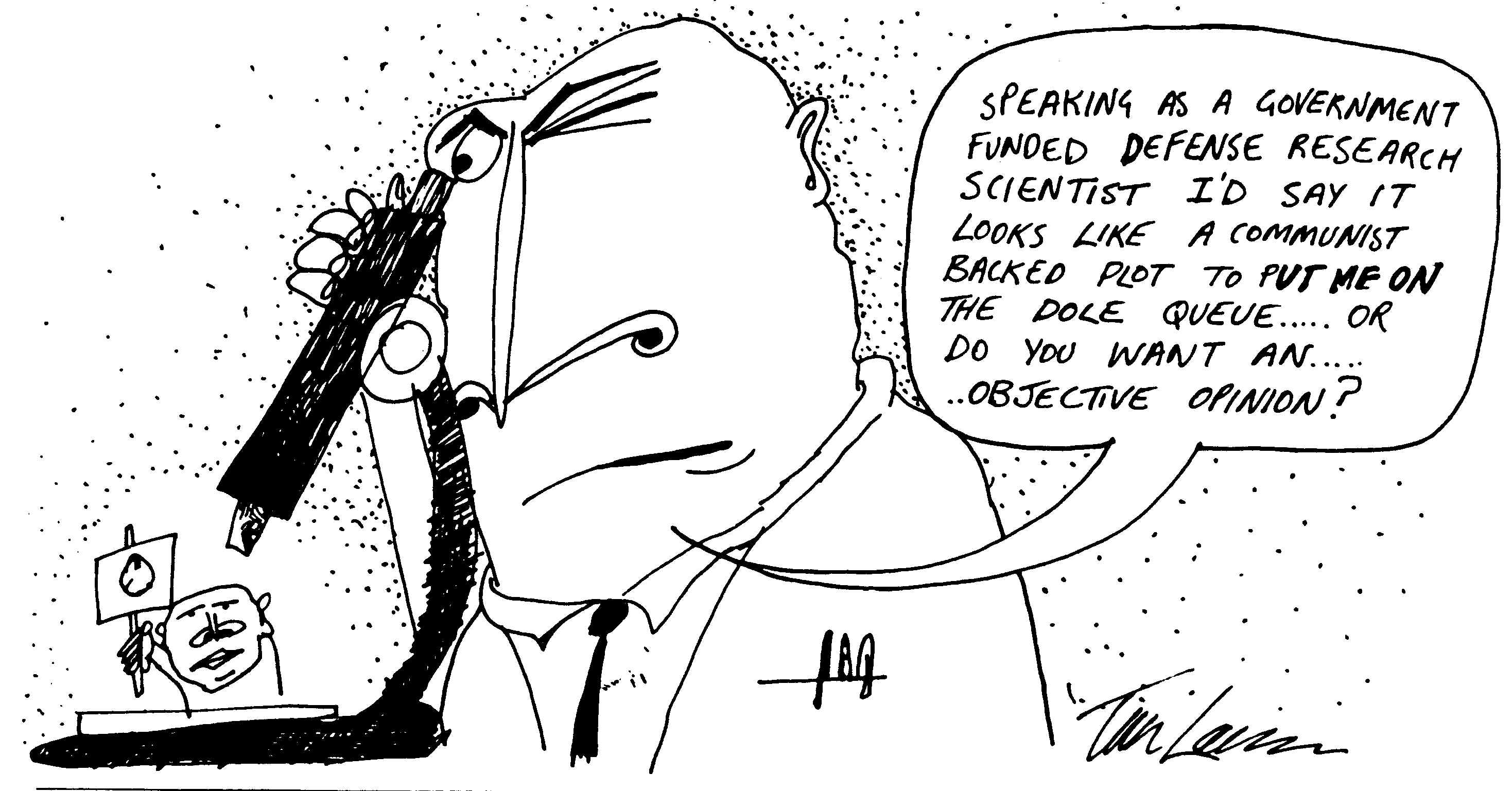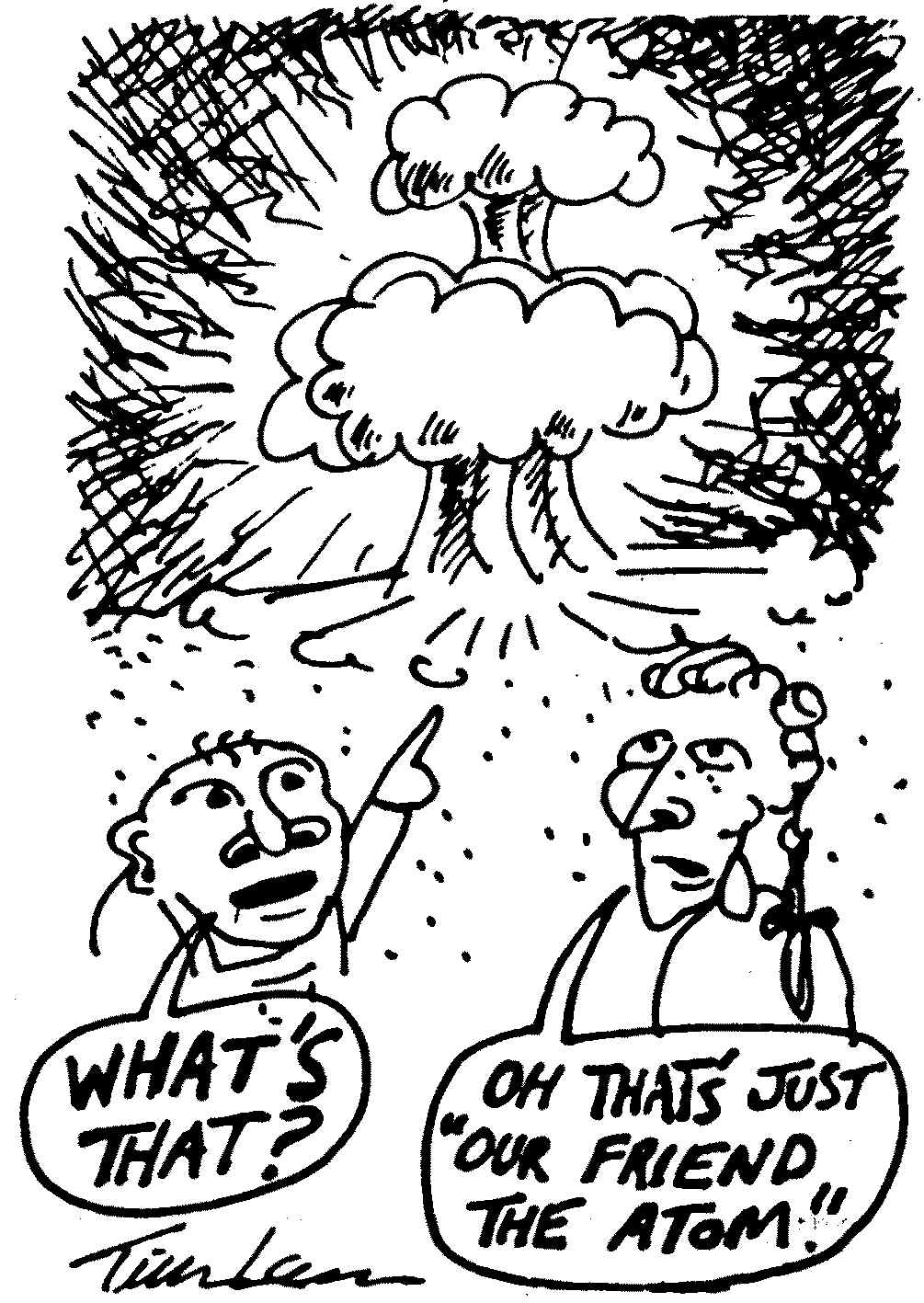
Published in Peace Studies, No. 7, October 1984, pp. 9-12
pdf of published article
Brian Martin's publications on peace and war
Brian Martin's publications on science, technology and society

Since the resurgence of the worldwide peace movement in the early 1980s, a great number of scientists and technologists have become active on peace issues. There are specific groups catering for occupations ranging from civil engineering to computer programming. Many individual scientists who have never before been involved in social action have taken public stands.
Historically this is quite an unusual situation. There are many influences on scientists which discourage social action. My aim here is to outline some of the factors influencing scientists towards either quiescence or activism, and to suggest a few ways in which the present wave of activism can be steered to maximise its lasting impact.
The normal operation of science is closely linked to the institutions behind war. There are several important mechanisms.[1] First, a major fraction of funding for science is directly or indirectly linked to military ends. Such funded research ranges from weather prediction to the psychology of soldiers. Funding priorities also influence the direction of technological innovation - such as the military promotion of computing - which then influences the ongoing development of science (see item on Strategic Computing in this issue). Another result of funding priorities is that what are seen as important scientific problems - in areas from remote sensing to plasma physics to the mathematical study of conflict situations - often become linked to military priorities or perspectives.
The key to the connection between science and war lies in the structure of the scientific community. Most modern scientific researchers are full-time professionals working on specialised topics in a bureaucratic setting of government, university or corporation. This way of organising science is fairly recent, and results from the capturing and incorporation of the scientific enterprise into the dominant institutions of the state (including the government, state bureaucracies, and the military) and corporations.[2] The state and to a lesser degree corporations provide funding for science, and they also provide positions of influence to scientific elites. To gain access to this money and power, science has been restructured to be highly professionalised, bureaucratised, specialised and, at the level of interaction with the state and corporations, hierarchical. Each of these features of science makes it selectively useful to the state and corporations: professionalisation and bureaucratisation tie scientists to the projects actually or potentially useful to the funders of science; specialisation makes the results of scientific research difficult to use except by large-scale, bureaucratic organisations; and hierarchy cuts off participation by scientists in major decision-making about research priorities.
Science is also an intensely masculine occupation, manifesting the typically male values of competition, emotional aloofness and objectification of nature (including both women and the natural environment). These values are shared by the military, so it is not surprising that the results of 'masculine' research - based on the aim of domination and manipulation of nature - are so readily used for military purposes.

This incorporation of science into dominant institutions is the reason why so few scientists have become involved in antiwar activities. But the structural pressures for quiescence and sticking at the narrow research task at hand are not all-powerful. At all times, there are individuals who refuse the terms of orthodox science, due to individual conviction. This conviction is often linked to radicalising experiences, or to belonging to communities of resistance such as the Quakers. And when social movements expand and influence community attitudes, then significant numbers of scientists may begin overtly addressing social issues. This has happened in Australia on a number of occasions, such as during the height of the uranium debate during the late 1970s, and now during the boom in the peace movement in the 1980s.
It should not be imagined that scientists who make public statements or join rallies are being more political than those who remain in their offices and laboratories. The latter group cannot escape the structural influences of funding, bureaucratisation and selective usefulness of scientific results. Their research is inevitably value-laden due to the values embedded in the context of their research, both organisationally and theoretically.[3] Those who become 'socially active' are merely being more overt in attempting to link their values and their actions.
But even those who join peace groups and groups for social responsibility of scientists often reflect in their behaviour the institutional pressures under which they continue to work. There are several typical paths for scientist activists.
In order to continue to maintain their scientific credibility among peers - in other words, to make their activism compatible with their careers as scientists - many scientist activists try to be seen to be 'socially responsible'. One way to do this is to draw on one of the dominant themes in the ideological justification for science: the search for truth. Following this line, 'responsible' scientists prefer to offer only 'objective' comment on social issues. But although this approach draws its justification from the alleged neutrality of science, the practice of 'social responsibility' is not socially neutral in application, since any public comment on social issues is inevitably political in impact. Since most experts work for dominant institutions such as the military and critical technical comment is scarce, those who offer 'objective' comment on the issues in public often end up aiding the critics of established institutions.
However, the stance of providing allegedly 'objective' comment in the public arena is inherently unstable. Scientists who do this are seen as political by colleagues and superiors and can come under pressure to reduce their public activity. This pressure often can be withstood while social movements make public comment on the issues hard to suppress. But when the issue becomes less salient publicly, or more overtly politicised so that the stance of making ostensibly objective comment is hard to maintain, then a withdrawal of effort is one likely possibility.
Another possible response to the conflicting pressures on those who offer 'objective' comment is a shift to more political involvement in the issue. Those taking this path then join others who started out with such an orientation. Many who do this draw on a different theme in the ideological justification for science: service to humanity. The prevailing interpretation of this theme is that scientists should do their job well, and let society (that is, in practice, elite decision-makers) decide how scientific results are used. This is then supposed to lead to proper use of the benefits of science. But the results - such as nuclear, biological and chemical weapons - have often led scientists to question their passivity in the decisions about applications of science. Such questioners may become socially active in a way which is political in a relatively overt way.
As long as social movements are strong, such involvement may be possible to sustain. But the pressures on socially active scientists can be very great. Many will be encouraged to return to the lab after the shouting has died down. Others, in the early stages of their careers or without a secure foothold, will be forced out of science if they do not conform. Still others who remain active in a conspicuous way will be subject to harassment, denial of research funding, blocking of career advancement and sometimes dismissal attempts.[4]

Not only is the amount of social activism strongly influenced by the social environment in which scientists work, but so also is the style and type of their social involvement. In many ways the assumptions underlying the social activism of scientists reflect the assumptions underlying their training and their working conditions. Several typical features of the efforts of activist scientists illustrate this.
* Belief in rationality. Scientists carry out their research work assuming the use of the rational thinking to develop theories and examine evidence. Although this assumption is suspect even for scientific work,[5] scientists apply it in the public realm when they trust in the power of knowledge and logic alone to bring about better social outcomes. This assumption is shared by many others in peace movements. Unfortunately, much more than knowledge and logic are needed to bring about changes in the face of vested interests.
* Appeal to elites. Scientists are used to pursuing careers and building research empires by enhancing their scientific reputations among scientific elites and catering to the requirements of organisational elites. The orientation in public activism is often the similar one of taking arguments to political elites, who are then expected to implement rational policies based on advice from scientists. This approach is largely useless, I would argue, since the structural position of elites is the main determinant of their views, and they cannot be expected to undertake policies which will undermine their own power.
* Reliance on expertise. Scientists are experts, and so not surprisingly they tend to encourage dependence on their expertise. This means arguing social issues in technical terms, such as the familiar emphasis on the effects of nuclear war or the capabilities of the latest war technologies. Much of this effort is quite valuable, but often it also has the effect of removing the debate from political fundamentals and of disempowering those who are not experts.
* Separation of work and activism. Scientist activists usually still have to continue their research or teaching, and so are not encouraged to make a critique of the nature of science as part of a critique of the institutions of the war system. To avoid this dilemma, many scientists can survive by pursuing their activism in an area not directly threatening to their immediate co-workers. For example, biologists may enter the nuclear debate. In my opinion, often this is quite a sensible thing to do. After all, not many bomb designers can join antiwar movements and maintain their jobs.
Much of the present involvement of numerous scientists and engineers in peace-related activism is unlikely to survive a serious decline in the public strength and visibility of the peace movement - a decline which, by historical evidence, is virtually inevitable.[6] To build involvement by scientists which is more lasting is not an easy task. Experiences with earlier movements and struggles suggest several ways which may inhibit the normal return to quiescence.
(1) Physical and/or organisational closeness of key individuals. Many social action groups keep going because of the commitment of a few core members. If several individuals set up ongoing activities and personal linkages - including such mundane things as regular and convenient meeting times - continued activism is much more likely. This seems to be one reason why the Society for Social Responsibility in Science in Canberra kept going many years after similar groups in other cities collapsed.
Therefore it is important that scientist activists, as well as concentrating on doing particular tasks, also try to develop groups, routines and styles of activity which are easy to become engaged in and which are personally satisfying.
(2) An ongoing activity. If there is something to do that requires continuing involvement, it will often stimulate the involvement it requires. One example is producing or distributing a journal, such as the US radical science movement's journal Science for the People, which is a focus for many local groups in the Science for the People network. Another focus could be routine consulting with community groups or trade unions. It is worth devoting a lot of attention and effort to developing such ongoing activities, especially activities which encourage participation of new people.
(3) An institutional location. Peace studies or environmental programmes may provide havens for radical scientists. Often they do not. But even if all non-tenured staff are dropped from such programmes - as has happened from some transdisciplinary environmental programmes in the US[7] - they can provide a useful base for socially relevant teaching and research by scientists who otherwise would be subjected to pressures to conform to orthodox research and teaching. Indeed, success in changing institutional arrangements is one criterion for the success of any social movement.
It is important to push not only for specific research and teaching programmes concerning peace issues, but also for regular examination and redirection of orthodox research and teaching in the light of wider social concerns. For example, a research group might establish a standard procedure whereby a panel of citizens, including for example members of community groups and trade unions, is regularly informed of research developments and which offers advice to the scientists about what the panel members consider to be socially desirable directions for research.
(4) Links with ongoing social struggles. The British Society for Social Responsibility in Science adopted radical stances in the early 1970s and this led to most establishment members dropping out. The BSSRS as a radical science group eventually focussed on issues of worker health and safety and thus built up a political practice which incorporated a critique of orthodox science and a link with ongoing social struggles.[8] In such cases the main social base of support usually is people on the fringe of science, such as Ph.D. students and drop-outs from science, along with a core of tenured radicals.
(5) Scientists in social action groups. One of the most important ways to challenge the present incorporation of science in the war system is to encourage more mainstream scientists to become involved in social action groups as regular members. This will require some efforts by activists, whose styles sometimes can alienate scientists, for example when public claims are made on the basis of inadequate information. It will also require some tolerance from activist scientists of the different mode of operation in social action groups, such as the making of political rather than purely intellectual stands.
Scientists in social action groups can provide valuable skills in critical thinking. They also can learn a lot about political action, and this understanding then has a chance of being applied within scientific organisations themselves.
1. These Points are dealt with in somewhat more detail in Brian Martin, 'Science and War', in: Arthur Birch (editor), Science Research In Australia: Who Benefits? (Canberra: Centre for Continuing Education, Australian National University, 1983), pages 101-108. For detailed examples see especially Robin Clarke, The Science of War and Peace (London: Jonathon Cape, 1971).
2. See Hilary Rose and Steven Rose (editors), The Political Economy of Science and The Radicalisation of Science (London: Macmillan, 1976).
3. Brian Martin, The Bias of Science (Canberra: Society for Social Responsibility in Science (ACT), 1979).
4. Brian Martin, 'The scientific straightjacket', Ecologist, Volume 11, Number 1, January/February 1981, pages 33-43.
5. See for example Ian I. Mitroff, The Subjective Side of Science (Amsterdam: Elsevier, 1974); Barry Barnes, Scientific Knowledge and Sociological Theory (London: Routledge and Kegan Paul, 1974); Paul Feyerabend, Science in a Free Society (London: NLB. 1978).
6. Nigel Young, 'Why peace movements fail', Social Alternatives, Volume 4, Number 1, March 1984, pages 9-16.
7. John Steinhart, personal communication.
8. On the fate of 1970s movements for social responsibility in science, see David Biggins, 'Social responsibility in science', Social Alternatives, Volume 1, Number 3, 1978, pages 54-60.
I thank Mark Diesendorf for useful comments on a draft of this article.